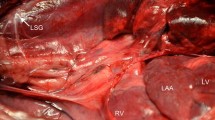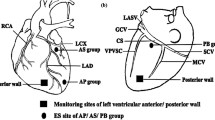Summary
The effect of the autonomic nerves on the transmural dispersion of ventricular repolarization in intact canine was investigated. By using the monophasic action potential (MAP) recording technique, monophasic action potentials (MAPs) of the epicardium (Epi), midmyocardium (Mid) and endocardium (Endo) were recorded simultaneously by specially designed plunge-needle electrodes at the left ventricular free wall in 12 open-chest dogs. MAPD90 and transmural dispersion of repolarization among three myocardial layers as well as the incidence of the EAD before autonomic that the MAPD90 of Epi, Mid and Endo before autonomic nervous stimulation were 278±11 ms, 316±16 ms and 270±12 ms respectively, the MAPD90 of Mid was significantly longer than that of Epi or Endo (P<0.01). MAPD90 of Epi, Mid and Endo were shortened by 19±4 ms, 45±6 ms, 18±3 ms respectively during sympathetic stimulation. Compared with that of the control, the transmural dispersion of repolarization during sympathetic stimulation was shortened from 44±4 ms to 15±3 ms (P<0.01), but early afterdepolarizations were elicited in the Mid of 5 dogs (41%) during sympathetic stimulation. Parasympathetic stimulation did not significantly affect the MAPD90 in the three layers. It is concluded that there is the transmural dispersion of ventricular repolarization in intact canine. Sympathetic stimulation can reduce transmural dispersion of repolarization, but it can produce early afterdepolarizations in the Mid. Parasympathetic stimulation does not significantly affect the transmural dispersion of ventricular repolarization.
Similar content being viewed by others
References
Sicouri S, Antzelevitch C. A subpopulation of cells with unique electrophysiological properties in the deep subepicardium of the canine ventricle: the M cells. Circ Res, 1991, 68: 1279
Liu S W, Lin Z H. The relationship between the autonomic nerves and arrhythmia. Chin J Cardiol (Chinese), 1999, 27(1):75
Li Y T, Zhang C T, Lu Z Y. Experimental observation on genesis of U wave in ECG in rabbits. Chin J Cardiol (Chinese), 2000, 28(2):124
Antzelevitch C, Sicouri S, Litovsky S Het al. Heterogeneity with the ventricular wall: electrophysiology and pharmacology of epicardial, endocardial and M cells. Circ Res, 1991, 69:1427
Zipes D P. Influence of myocardial ischemia and infarction on autonomic innervation of heart. Circulation, 1990, 82(4):1095
Burashnikov A, Antzelevitch C. Differences in the electrophysiologic response of four canine ventricular cell types to alpha1-adrenergic agonists. Cardiovasc Res, 1999, 43(4):901
Shimizu W, Antzelevitch C. Cellular basis for the ECG features of the LQT1 form of the long-QT syndrome: Effect of β-adrenergic agonists and antagonists and sodium channel blockers on transmural dispersion of repolarization and Torsade de Pointes. Circulation, 1998, 98:2314
Shimizu W, Antzelevitch C. Differential effects of beta-adrenergic agonists and antagonists in LQT1, LQT2 and LQT3 models of long QT syndrome. JACC, 2000, 35:778
Takei M, Sasaki Y, Yonezawa Tet al. The autonomic control of transmural dispersion of ventricular repolarization in anesthetized dog. J Cardiovasc Eletrophysiol, 1999, 10(8):124
Priori S G, Mantica M, Schwartz P J. Delayed afterdepolarizations elicited in vive by left stellate ganglion stimulation. Circulation, 1988, 78:178
Antzelevith C, Sicouri S. Clinical relevance of cardiac arrhythmia generated by afterdepolarizations: The role of M cells in the generation of U waves, triggered activity and torsade de pointes. JACC 1994, 23:259
Author information
Authors and Affiliations
Additional information
Zhang Cantai, male, born in 1963, Associate Professor
Rights and permissions
About this article
Cite this article
Cuntai, Z., Dawen, X., Yang, L. et al. Effect of autonomic nervous system on the transmural dispersion of ventricular repolarization in intact canine. Current Medical Science 24, 37–40 (2004). https://doi.org/10.1007/BF02830701
Received:
Published:
Issue Date:
DOI: https://doi.org/10.1007/BF02830701




